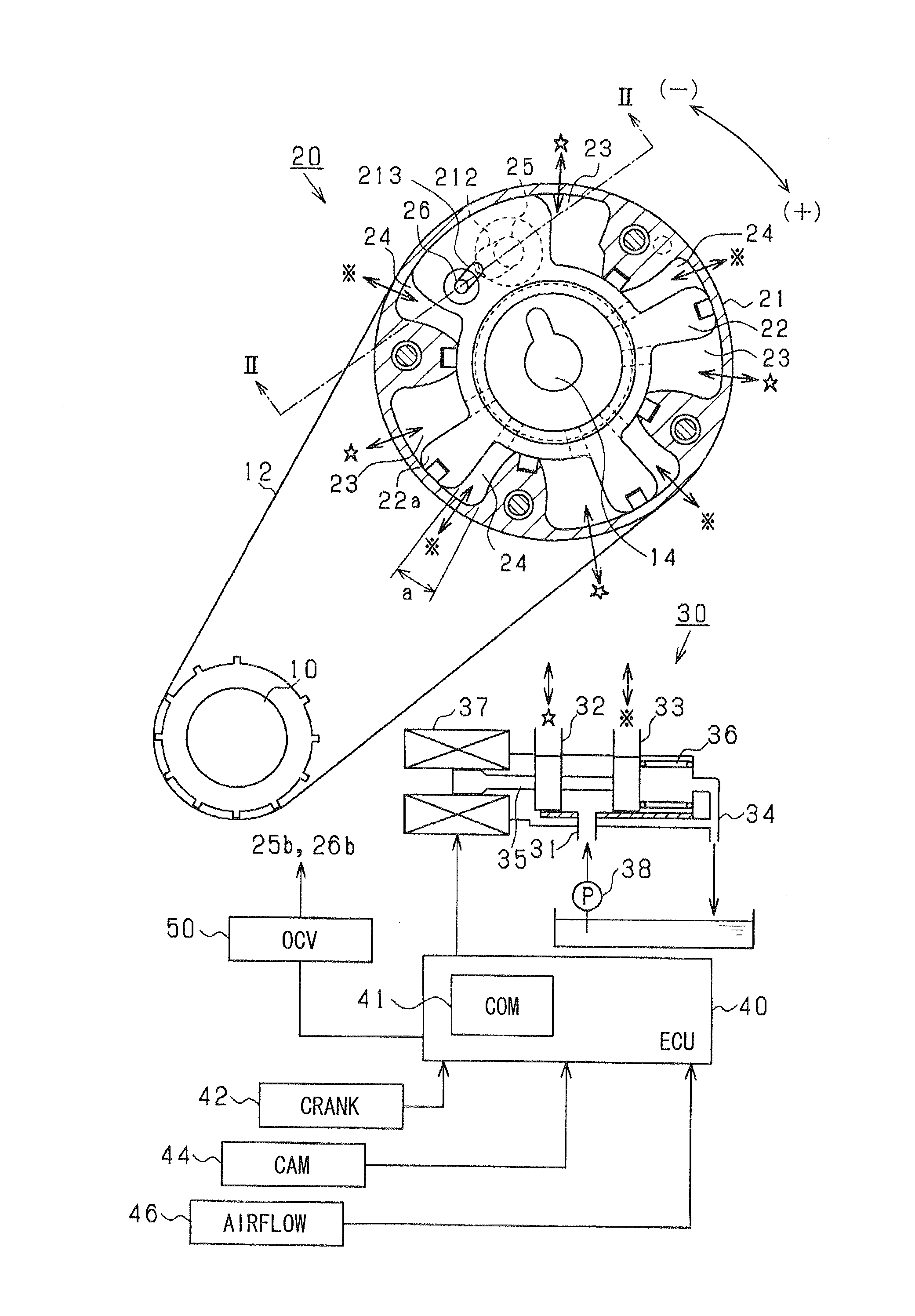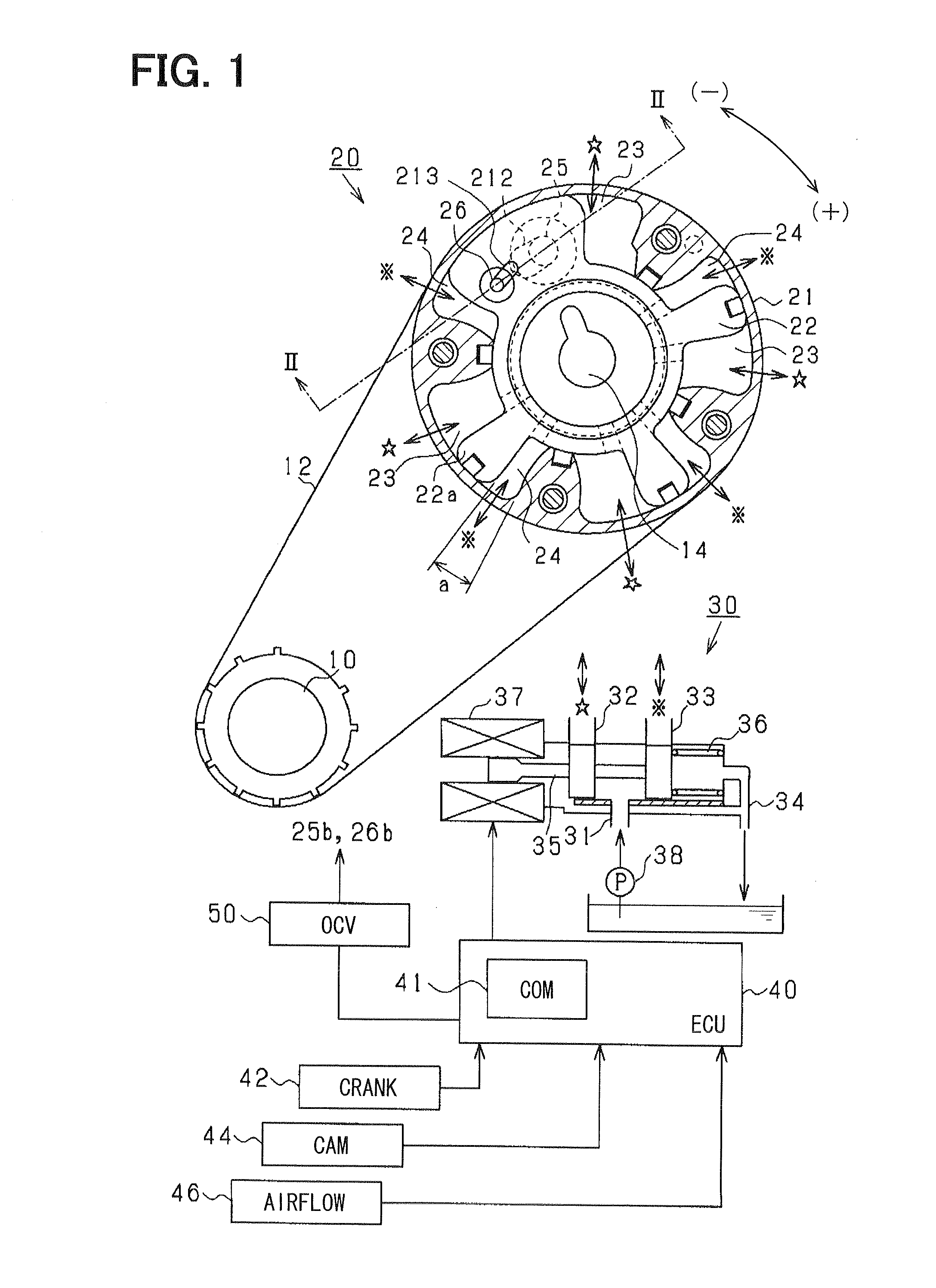Variable valve timing device
a timing device and variable valve technology, applied in valve arrangements, machines/engines, mechanical equipment, etc., can solve problems such as the failure of the lock pin by sticking in the bore, and achieve the effect of restricting the relative rotation range of the rotor
- Summary
- Abstract
- Description
- Claims
- Application Information
AI Technical Summary
Benefits of technology
Problems solved by technology
Method used
Image
Examples
first embodiment
[0038]FIG. 1 is a block diagram showing a variable valve timing device according to a first embodiment of the present invention.
[0039]As shown in the drawings, a variable valve timing device (VVT) 20 is disposed in a drive train for transmitting valve driving force from a crankshaft (output shaft) 10 to a camshaft 14 of an engine. The drive train is provided by a belt drive mechanism including a belt 12 and pulleys. The VVT 20 is provided with a first rotor (housing) 21 which is mechanically connected with the crankshaft 10, and a second rotor (vane rotor) 22 which is mechanically connected with the camshaft 14. The second rotor 22 is provided with a plurality of radially protruded portions (vanes) 22a, and is rotatably housed in an inner chamber defined in the first rotor 21. The VVT 20 includes a plurality of pairs of a retarding chamber 23 and an advancing chamber 24. The retarding chamber 23 retards (−) the relative rotational position when the retarding chamber 23 increases the...
second embodiment
[0112]A VVT in this embodiment does not have the restriction pin 26 and the restriction slot 213 in the above-mentioned first embodiment. Other mechanical configurations are the same as the first embodiment. The COM 41 performs process shown in FIGS. 15 and 16 to determine that whether the lock pin 25 is stuck or not.
[0113]FIG. 15 shows determining process for the LPF of the lock pin 25. The determining process causes the ECU 40 to provide means for determining the LPF. The process is designed to determine the LPF, if the LRC is satisfied and the relative rotation of the rotors 21 and 22 can not be changed from the inside to the outside of the first restricted range W1 defined by the guide slot 212. In other words, the process determines the LPF, if the VVT 20 can not be rotated to an outside region from the first restricted range W1 during the LRC is satisfied.
[0114]In a step S100, it is determined that whether the LRC is satisfied or not. In a step S101, it is determined that whet...
third embodiment
[0118]As shown in FIG. 17, a VVT in a third embodiment does not include the lock slot 211 in the first embodiment. As shown in FIG. 18, the VVT provides a first restricted range W10 provided by the first restriction slot 212 and a second restricted range (additional restricted range) W20 provided by the second restriction slot 213. The ranges W10 and W20 are arranged as shown in FIG. 18. Other configurations are the same as the first embodiment.
[0119]In this embodiment, the VVT includes a first restriction pin 25 and a second restriction pin 26 provided on the second rotor 22. The pins 25 and 26 are projected from the second rotor 22 to the projected position when a restriction-pin-projecting condition provided as the restricting condition is satisfied. The pins 25 and 26 are retracted into the second rotor 22 to the retracted position when a restriction-pin-retracting condition provided as the enabling condition is satisfied. The VVT includes a first restriction slot 212 provided o...
PUM
 Login to View More
Login to View More Abstract
Description
Claims
Application Information
 Login to View More
Login to View More - R&D
- Intellectual Property
- Life Sciences
- Materials
- Tech Scout
- Unparalleled Data Quality
- Higher Quality Content
- 60% Fewer Hallucinations
Browse by: Latest US Patents, China's latest patents, Technical Efficacy Thesaurus, Application Domain, Technology Topic, Popular Technical Reports.
© 2025 PatSnap. All rights reserved.Legal|Privacy policy|Modern Slavery Act Transparency Statement|Sitemap|About US| Contact US: help@patsnap.com



